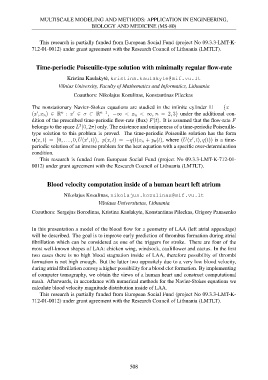Page 510 - 8th European Congress of Mathematics ∙ 20-26 June 2021 ∙ Portorož, Slovenia ∙ Book of Abstracts
P. 510
MULTISCALE MODELING AND METHODS: APPLICATION IN ENGINEERING,
BIOLOGY AND MEDICINE (MS-80)
This research is partially funded from European Social Fund (project No 09.3.3-LMT-K-
712-01-0012) under grant agreement with the Research Council of Lithuania (LMTLT).
Time-periodic Poiseuille-type solution with minimally regular flow-rate
Kristina Kaulakyte˙, kristina.kaulakyte@mif.vu.lt
Vilnius University, Faculty of Mathematics and Informatics, Lithuania
Coauthors: Nikolajus Kozulinas, Konstantinas Pileckas
The nonstationary Navier–Stokes equations are studied in the infinite cylinder Π = {x =
(x , xn) ∈ Rn : x ∈ σ ⊂ Rn−1, −∞ < xn < ∞, n = 2, 3} under the additional con-
dition of the prescribed time-periodic flow-rate (flux) F (t). It is assumed that the flow-rate F
belongs to the space L2(0, 2π) only. The existence and uniqueness of a time-periodic Poiseuille-
type solution to this problem is proved. The time-periodic Poiseuille solution has the form
u(x, t) = 0, . . . , 0, U (x , t) , p(x, t) = −q(t)xn + p0(t), where (U (x , t), q(t)) is a time-
periodic solution of an inverse problem for the heat equation with a specific over-determination
condition.
This research is funded from European Social Fund (project No 09.3.3-LMT-K-712-01-
0012) under grant agreement with the Research Council of Lithuania (LMTLT).
Blood velocity computation inside of a human heart left atrium
Nikolajus Kozulinas, nikolajus.kozulinas@mif.vu.lt
Vilniaus Universitetas, Lithuania
Coauthors: Sergejus Borodinas, Kristina Kaulakyte, Konstantinas Pileckas, Grigory Panasenko
In this presentation a model of the blood flow for a geometry of LAA (left atrial appendage)
will be described. The goal is to improve early prediction of thrombus formation during atrial
fibrillation which can be considered as one of the triggers for stroke. There are four of the
most well-known shapes of LAA: chicken wing, windsock, cauliflower and cactus. In the first
two cases there is no high blood stagnation inside of LAA, therefore possibility of thrombi
formation is not high enough. But the latter two oppositely due to a very low blood velocity,
during atrial fibrillation convey a higher possibility for a blood clot formation. By implementing
of computer tomography, we obtain the views of a human heart and construct computational
mesh. Afterwards, in accordance with numerical methods for the Navier-Stokes equations we
calculate blood velocity magnitude distribution inside of LAA.
This research is partially funded from European Social Fund (project No 09.3.3-LMT-K-
712-01-0012) under grant agreement with the Research Council of Lithuania (LMTLT).
508
BIOLOGY AND MEDICINE (MS-80)
This research is partially funded from European Social Fund (project No 09.3.3-LMT-K-
712-01-0012) under grant agreement with the Research Council of Lithuania (LMTLT).
Time-periodic Poiseuille-type solution with minimally regular flow-rate
Kristina Kaulakyte˙, kristina.kaulakyte@mif.vu.lt
Vilnius University, Faculty of Mathematics and Informatics, Lithuania
Coauthors: Nikolajus Kozulinas, Konstantinas Pileckas
The nonstationary Navier–Stokes equations are studied in the infinite cylinder Π = {x =
(x , xn) ∈ Rn : x ∈ σ ⊂ Rn−1, −∞ < xn < ∞, n = 2, 3} under the additional con-
dition of the prescribed time-periodic flow-rate (flux) F (t). It is assumed that the flow-rate F
belongs to the space L2(0, 2π) only. The existence and uniqueness of a time-periodic Poiseuille-
type solution to this problem is proved. The time-periodic Poiseuille solution has the form
u(x, t) = 0, . . . , 0, U (x , t) , p(x, t) = −q(t)xn + p0(t), where (U (x , t), q(t)) is a time-
periodic solution of an inverse problem for the heat equation with a specific over-determination
condition.
This research is funded from European Social Fund (project No 09.3.3-LMT-K-712-01-
0012) under grant agreement with the Research Council of Lithuania (LMTLT).
Blood velocity computation inside of a human heart left atrium
Nikolajus Kozulinas, nikolajus.kozulinas@mif.vu.lt
Vilniaus Universitetas, Lithuania
Coauthors: Sergejus Borodinas, Kristina Kaulakyte, Konstantinas Pileckas, Grigory Panasenko
In this presentation a model of the blood flow for a geometry of LAA (left atrial appendage)
will be described. The goal is to improve early prediction of thrombus formation during atrial
fibrillation which can be considered as one of the triggers for stroke. There are four of the
most well-known shapes of LAA: chicken wing, windsock, cauliflower and cactus. In the first
two cases there is no high blood stagnation inside of LAA, therefore possibility of thrombi
formation is not high enough. But the latter two oppositely due to a very low blood velocity,
during atrial fibrillation convey a higher possibility for a blood clot formation. By implementing
of computer tomography, we obtain the views of a human heart and construct computational
mesh. Afterwards, in accordance with numerical methods for the Navier-Stokes equations we
calculate blood velocity magnitude distribution inside of LAA.
This research is partially funded from European Social Fund (project No 09.3.3-LMT-K-
712-01-0012) under grant agreement with the Research Council of Lithuania (LMTLT).
508


